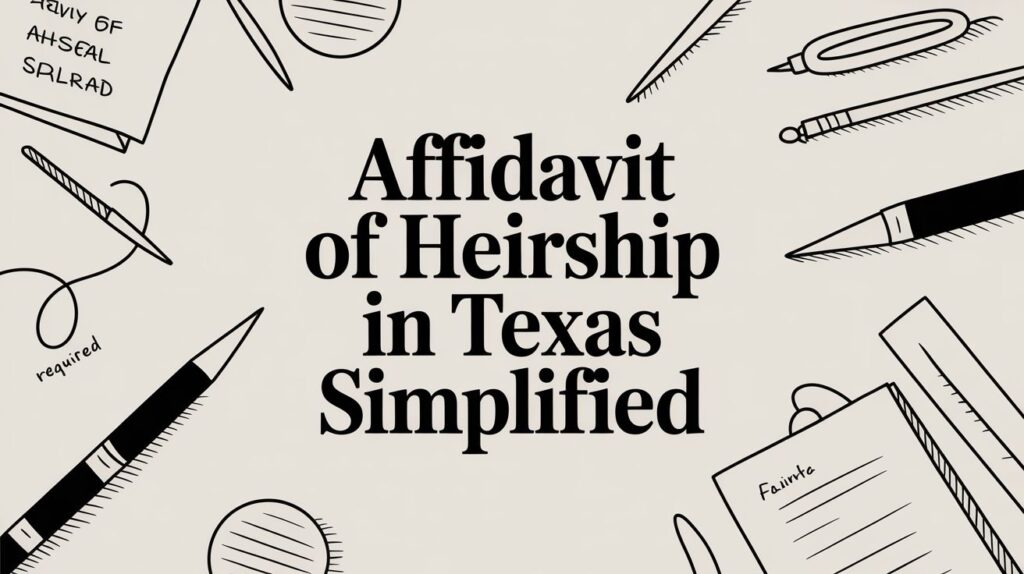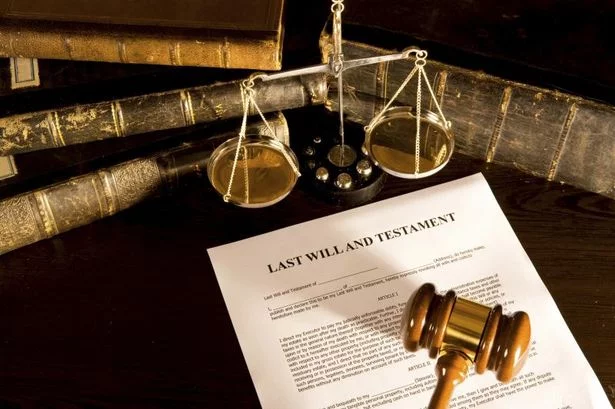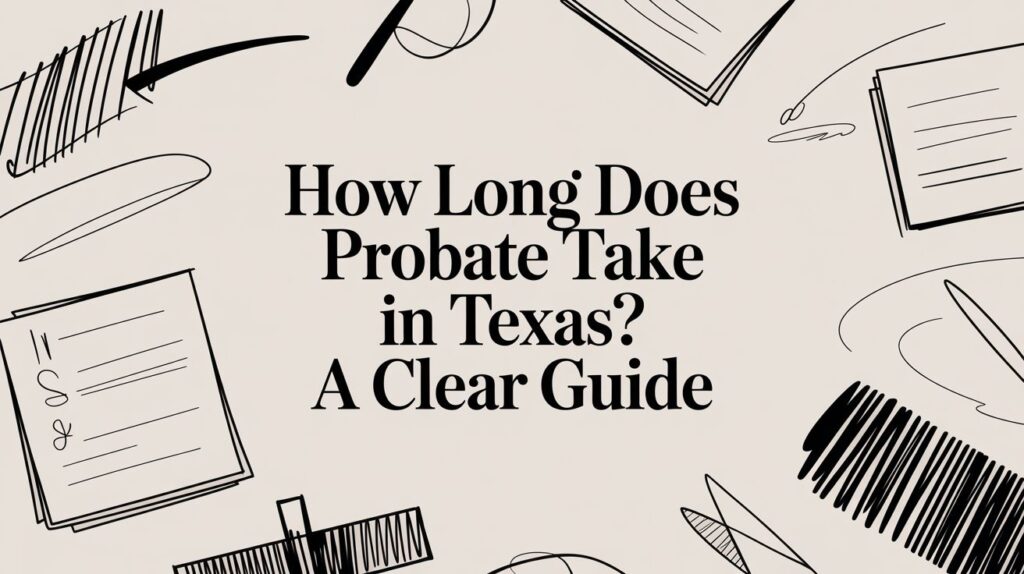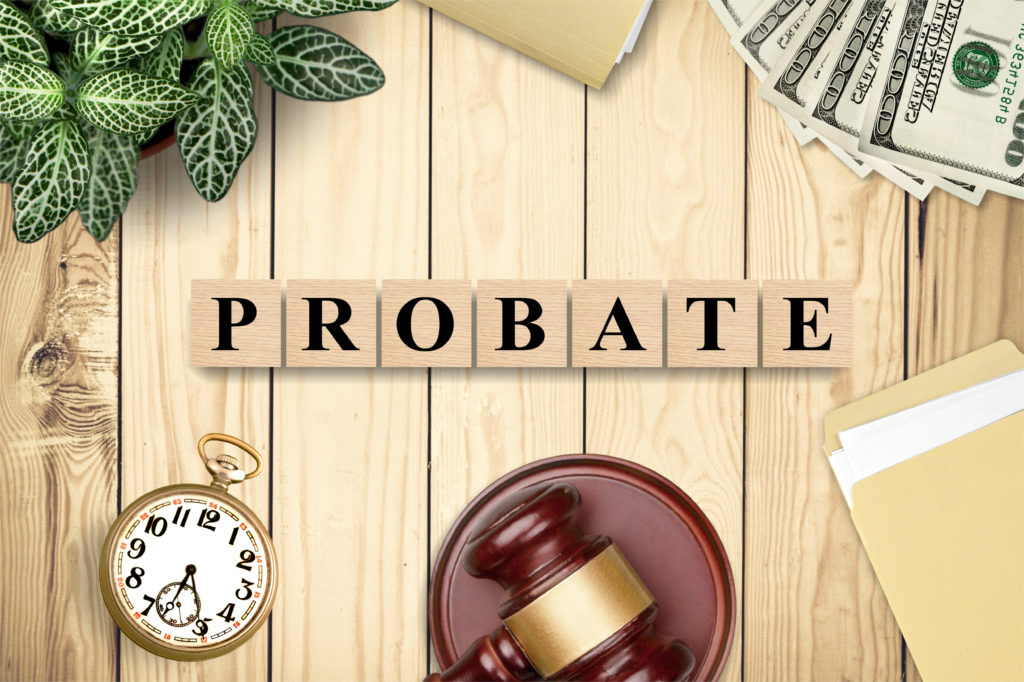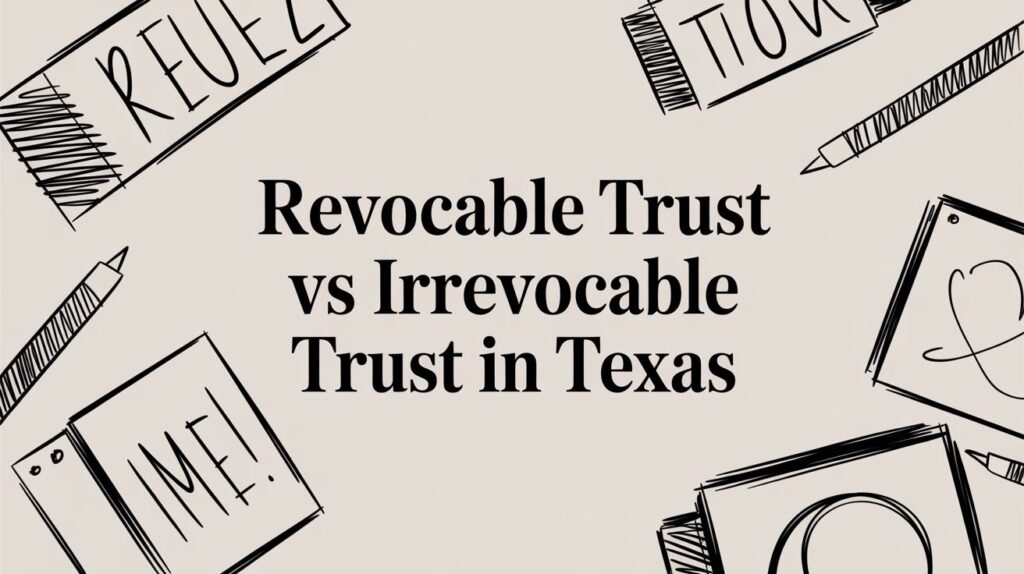When a loved one can no longer make safe or sound decisions on their own, families are often thrown into a difficult and emotional reality. You start worrying—can they manage their daily tasks? Are the bills getting paid? Who will consent to medical care if they can't?
Legal guardianship in Texas is the court-supervised process designed for these exact moments. A judge appoints a responsible person, the guardian, to make critical decisions for an individual who can no longer care for themselves, known as the ward. It's a significant legal step, taken only when absolutely necessary to protect a vulnerable person's health, safety, and financial well-being. This process is carefully outlined in Title 3 of the Texas Estates Code to ensure every action is taken with the utmost care.
Understanding the Purpose of Texas Guardianship
Think of guardianship as a structured, legal safety net. It’s not a punishment or a way to take away someone’s freedom for no reason. Instead, it’s a protective measure overseen by the courts to prevent abuse and ensure every decision is made in the best interest of the incapacitated person.

This process provides a clear framework for managing someone's affairs when they've lost the ability to do so themselves. It’s a heavy responsibility, and you can learn more about what it truly means for someone to be under this type of care in our guide on what a ward of the state means.
Two Primary Types of Guardianship
The Texas Estates Code doesn't take a one-size-fits-all approach. It wisely divides guardianship into two main categories, which a judge can grant separately or together depending on what the person truly needs.
- Guardian of the Person: This guardian makes decisions about the ward’s personal and medical well-being. Think of it as managing their day-to-day life—deciding where they live, what medical treatments they receive, and ensuring their daily needs are met. This is a plain-English way of saying they are responsible for the ward’s physical care and comfort.
- Guardian of the Estate: This guardian is all about the finances. They are responsible for managing the ward’s property, money, and other assets. Their job involves everything from paying bills and filing taxes to investing funds, all under the strict supervision of the court. This person acts as a "fiduciary," a legal term meaning they must act solely in the ward's financial best interest.
This separation is key. It allows a judge to tailor the guardianship to the specific situation, preserving as much of the individual’s independence as possible while protecting them where they are most vulnerable.
Common Scenarios Leading to Guardianship
So, when does guardianship actually come into play? It's typically considered when a loved one's ability to make decisions has been seriously compromised. The goal is always to match the level of support to the individual's specific needs.
Here’s a look at some common situations where legal guardianship becomes a necessary step.
When Legal Guardianship Applies in Texas
| Situation | Guardianship Type | Primary Objective |
|---|---|---|
| Severe cognitive decline (e.g., late-stage dementia) | Guardian of the Person & Estate | Provide comprehensive care and financial management. |
| A significant developmental disability | Limited Guardian of the Person | Assist with specific life decisions while promoting autonomy. |
| A sudden, incapacitating injury (e.g., TBI) | Temporary Guardian of the Person & Estate | Make urgent medical and financial decisions during recovery. |
| Mismanagement of finances due to impairment | Guardian of the Estate | Protect assets from fraud, waste, or exploitation. |
As you can see, each scenario calls for a different level of intervention. The legal process is designed to be flexible enough to address these unique challenges.
Ultimately, seeking a legal guardianship in Texas is about stepping in with compassion and legal authority when a loved one is at their most vulnerable. It provides peace of mind that their health and financial security are in safe, responsible hands.
Different Types Of Guardianship In Texas
When you start exploring legal guardianship in Texas, you quickly learn it’s not a one-size-fits-all solution. The Texas Estates Code outlines several distinct guardianship options, each tailored to specific needs while protecting as much personal freedom as possible. At its core, the court’s mission is to impose the least restrictive arrangement necessary.
Broadly speaking, guardianships break down into two pillars: Guardian Of The Person and Guardian Of The Estate. A judge may appoint one or both, based entirely on the ward’s unique circumstances and level of incapacity.
Guardian Of The Person
Think of the Guardian Of The Person as the coordinator of daily life. This role focuses on the ward’s physical safety and emotional comfort, stepping in when they can’t manage certain day-to-day decisions alone. Key responsibilities include:
- Healthcare: Approving treatments, selecting physicians, and accessing medical records
- Living Arrangements: Choosing between home care, assisted living, or a nursing facility
- Daily Care: Overseeing nutrition, clothing, and personal hygiene
For example, imagine an adult daughter named guardian for her mother with advanced Alzheimer’s. She’d have the authority to schedule surgeries, liaise with nurses, and arrange a cozy, secure living environment.
Guardian Of The Estate
If the Person guardian looks after well-being, the Guardian Of The Estate manages the ward’s financial world. Picture a court-supervised trustee whose job is to protect and grow assets responsibly. This guardian handles:
- Bill payments and bank account oversight
- Tax filing and compliance
- Real estate and investment management
- Applications for benefits like Social Security or Medicaid
Consider a man recovering from a traumatic brain injury. His brother, as Guardian Of The Estate, would pay the mortgage, cover medical bills, and keep family assets safe from fraud or waste during recovery.
Temporary Vs Permanent Guardianship
Guardianship isn’t always long-term. A Temporary Guardianship acts like an emergency brake—available for up to 60 days when a sudden health crisis or financial threat arises. It gives loved ones the power to make urgent decisions without delay.
On the flip side, Permanent Guardianship is a lasting solution crafted through a full court hearing. You begin by filing an application in the probate court of the ward’s county. From there, the court orders:
- Background Checks: Fingerprinting and criminal history review
- Capacity Evaluation: Medical or psychological assessment by a licensed expert
- Independent Investigation: A court-appointed investigator or guardian ad litem vets the guardian’s suitability
Discover more insights about this detailed process.
Limited Guardianship: The Preferred Approach
Texas law prizes individual autonomy, which is why Limited Guardianship often takes center stage. Under this arrangement, a guardian only receives the specific powers the ward can’t handle—leaving all other rights intact.
Imagine someone in early-stage dementia who still makes sound healthcare choices but struggles with complex investments. A judge could grant limited guardianship of the estate, helping with finances but letting the ward decide on daily matters. This balance preserves dignity and respect throughout the Guardianship process.
Key Insight
Temporary orders allow Texas courts to act quickly in a crisis, while permanent arrangements ensure long-term care is established with careful due process. The preference is always for a Limited Guardianship that preserves the ward's independence as much as possible.
Navigating the Guardianship Application Process
Starting the process for legal guardianship in Texas can feel like mapping out a long road trip. You know the destination, but the route requires careful planning, attention to detail, and a clear understanding of every turn. Your first step is to gather all the essential paperwork to build a solid case for the court. This initial collection of documents is the foundation for everything that follows.
Filing the application is your official starting line. This legal document, formally known as the "Application for Appointment of a Permanent Guardian," must be filed in the probate court of the county where your loved one lives. It's a detailed form that tells the court about the proposed ward, you (the applicant), and exactly why a guardianship is needed.
Key Documents You Will Need
Before you can even think about filing, you need to assemble your application toolkit. Having everything organized and ready from the get-go helps prevent frustrating delays down the line.
- Physician's Certificate of Medical Examination: This is a crucial piece of evidence. It's a signed statement from a doctor, completed within the last 120 days, that details your loved one's physical and mental state and confirms their incapacity.
- A Complete List of Relatives: The court must notify all interested parties. This includes the proposed ward's spouse, children, parents, and siblings.
- Financial Information: If you're asking to be a Guardian of the Estate, you'll need to provide a clear picture of the proposed ward's assets, income, and any outstanding debts.
- Criminal History Background Check: The court needs to ensure you are a suitable and trustworthy person for this role, so a background check is mandatory.
This infographic breaks down the different hats a guardian can wear, which can help you figure out which type of guardianship is the right fit for your loved one's specific circumstances.
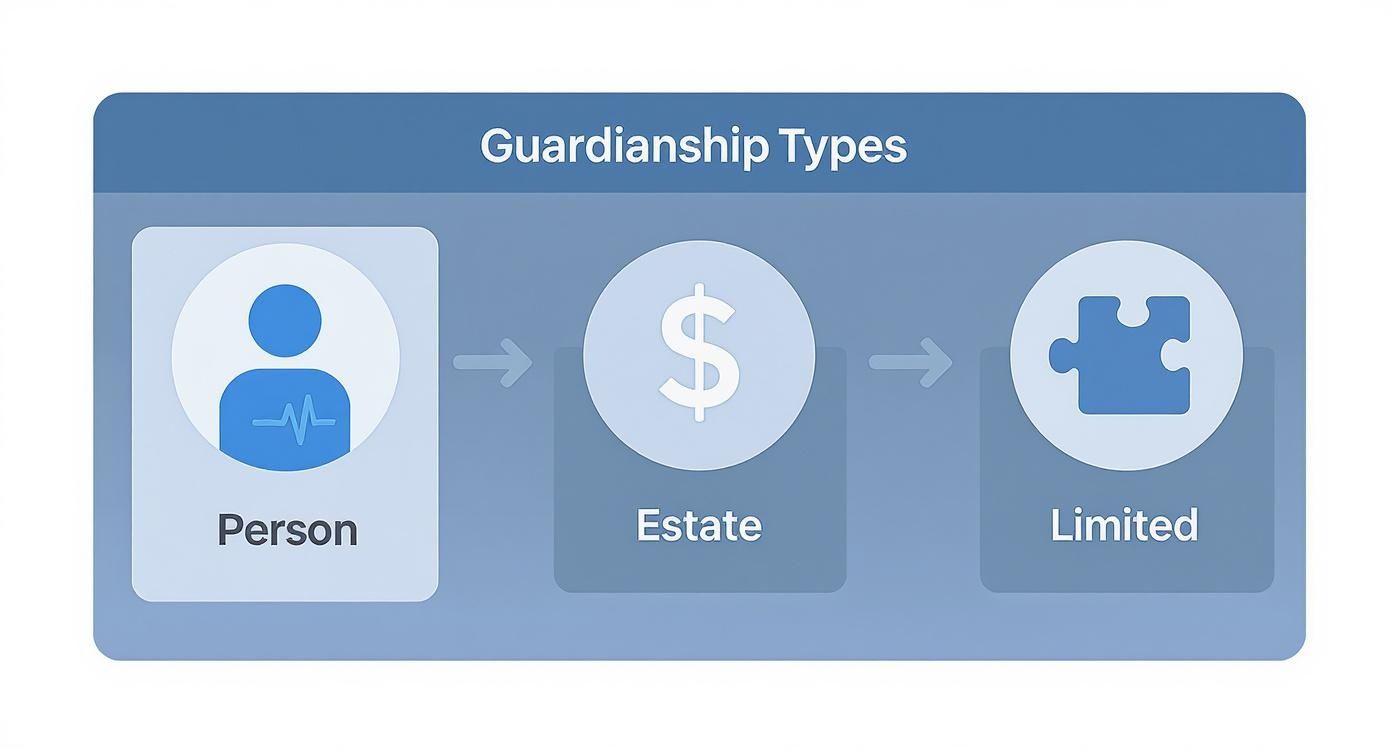
As the visual shows, guardianship isn't a one-size-fits-all solution. It can be tailored to manage someone's personal well-being, their financial life, or just a few specific needs, which lines up with the Texas court's preference for the least restrictive option possible. For law practices guiding clients through this maze, having essential IT solutions for law firms is key to keeping sensitive information secure and the process running smoothly.
Understanding the Court's Appointees
Once you've filed the application, the court appoints two independent professionals to protect the proposed ward’s rights. Their roles are designed to provide important checks and balances throughout the process.
- Attorney Ad Litem: This is an attorney the court assigns to be the proposed ward’s personal advocate. Their job is to meet with your loved one, explain what's happening in plain language, and make sure their wishes are represented in court.
- Guardian Ad Litem: Think of this person as the "eyes and ears" of the court. They conduct their own investigation by interviewing family, doctors, and caregivers. They then write a report for the judge with a recommendation on whether guardianship is truly in the proposed ward's best interest.
These appointees are vital. They give the judge an unbiased, 360-degree view of the situation before making a life-altering decision.
The Court Hearing and What to Expect
The final step is the hearing, where the judge pulls everything together—all the reports, evidence, and testimony. You'll be asked to speak under oath, and the judge will want to hear directly from you. Be prepared for questions like:
- Why won't less restrictive alternatives, like a power of attorney, work in this case?
- Can you give specific examples of your loved one's inability to care for themselves?
- What is your plan for managing their healthcare or financial decisions?
A Realistic Scenario: The Rodriguez family found themselves in this exact situation. Their father, Miguel, was diagnosed with rapidly progressing dementia. After a consultation, we helped them gather medical records and financial statements. We filed the application, and the court appointed an attorney ad litem who met with Miguel. At the hearing, his daughter, Sofia, explained how her father had recently wandered from home and was no longer paying his bills. The judge, having reviewed the reports, found clear evidence of incapacity and appointed Sofia as Guardian of the Person and Estate.
This careful, step-by-step process ensures every decision is made with the utmost legal oversight. The journey to secure guardianship for a parent is complex, and knowing what to expect can make all the difference. You can find more detailed guidance on how to get legal guardianship of a parent in our dedicated article. Because the court process is so detailed, having an experienced attorney in your corner is invaluable to avoid common mistakes and give your application the best chance of success.
Duties and Responsibilities of a Guardian
Once a Texas court officially appoints you as a guardian, you’re stepping into a role of incredible trust and serious legal responsibility. The law calls this a fiduciary duty, which is a formal way of saying you must always act in the best interests of the person you're protecting—the ward.
Think of yourself as the most dedicated advocate and manager for your loved one. Your job is to put their needs above all else, and the court is there to make sure everything is handled by the book.
The responsibilities are significant, but they aren't a mystery. The Texas Estates Code lays them out clearly. We can break these duties down into two main areas: managing their personal well-being and handling their financial affairs. This split mirrors the two main types of Guardianship a court might grant.
For the Guardian of the Person
If you’re named the Guardian of the Person, your focus is on the ward's day-to-day life, health, and safety. Your main goal is to ensure they live in a secure, supportive environment where their personal needs are met with dignity.
Your key duties include:
- Making Healthcare Decisions: You'll be the one consenting to medical treatments, choosing doctors, and making sure the ward gets proper care—from routine check-ups to major surgeries.
- Securing a Safe Home: You must decide where the ward will live. This could be at home with assistance, in an assisted living facility, or a nursing home. The environment must be safe, comfortable, and the least restrictive setting possible for their needs.
- Overseeing Daily Life: This involves managing everything from their nutrition and clothing to their social activities and general personal care, all to support their overall well-being.
- Reporting to the Court: Every year, you have to file an Annual Report on the Condition and Well-Being of the Ward. This document updates the court on their health, living situation, and any important changes over the past year.
For the Guardian of the Estate
As the Guardian of the Estate, you become the manager of the ward's financial world. It’s like being a meticulous household budget manager, but with the added weight of court supervision to protect the ward’s assets from being mishandled.
Your financial duties are strictly regulated and follow a clear timeline:
- Post a Bond: The court will almost always require you to buy a bond. This works like an insurance policy to protect the estate from any financial loss caused by your actions.
- Inventory the Estate: Within 30 days of your appointment, you must file a sworn "Inventory, Appraisement, and List of Claims." This is a complete, detailed list of all the ward's property and its value, submitted to the court for review.
- Manage Assets Prudently: You're in charge of paying bills, collecting any income, filing taxes, and managing investments. Every single financial move must be made for the sole benefit of the ward.
- File Annual Accountings: Each year, you have to submit a detailed financial report to the court. This report must show every dollar that came into the estate and every dollar that went out.
Key Insight
Meticulous record-keeping is your best friend. Keeping organized receipts, bank statements, and a log of all your decisions not only satisfies the court's requirements but also protects you from potential legal challenges down the road.
The court doesn't take these reporting duties lightly. In fact, a recent state review of guardianship cases revealed just how serious compliance issues can be. Out of 6,038 cases reviewed in fiscal year 2024, a staggering 16% were out of compliance. Of those, 29% were missing their annual accounts, and 30% were missing their initial inventories. You can read the full report on Texas guardianship compliance to see why diligent reporting is so critical.
Fulfilling the duties of a guardian is a demanding job, but it’s also a profoundly meaningful one. By understanding your obligations and keeping transparent records, you provide an invaluable service, ensuring your loved one is safe, cared for, and financially secure.
Guardianship for Minors in Texas
When most people hear the word "guardianship," their minds often jump to situations involving aging adults. But in Texas, legal guardianship is also a critical legal tool designed to protect children whose parents simply can't care for them anymore.
This can happen for a number of heartbreaking reasons—the sudden death of both parents who didn't have a will, a parent's debilitating illness, or in the toughest cases, situations involving abuse or neglect.
In these moments, the court's one and only job is to find a safe, stable, and loving home for the child. A guardian for a minor essentially steps into the parents' shoes, taking on the legal authority to make all the important life decisions.

Authority Granted to a Guardian of a Minor
When a Texas court appoints a guardian for a child, it’s not a small responsibility. They are granting that person significant power over the child's life, as laid out in the Texas Estates Code. The guardian is trusted to always act in the child's best interests.
This authority includes making decisions about:
- Education: Choosing which school the child attends, approving academic programs, and guiding their overall educational path.
- Healthcare: Giving consent for medical care, picking doctors and specialists, and managing the child's physical and mental well-being.
- Daily Life: Providing the basics like food, clothing, and shelter, while also shaping the child's upbringing and daily routines.
It's important to understand that this legal structure is different from other family law arrangements. For instance, it's not the same as having joint legal custody, which operates under a completely different set of rights and responsibilities.
When Guardianship Becomes Necessary
Guardianship for a minor is not just a temporary patch. It's a durable, court-supervised solution built for long-term stability. A common scenario is a family tragedy that leaves a child without parents to guide them.
Realistic Scenario: Sarah and Tom were the proud parents of their eight-year-old son, Leo. Tragically, a car accident took both of their lives, and they hadn't yet created a will to name a guardian. Leo’s maternal aunt, Maria, immediately stepped up. She filed an application for guardianship with the court. After reviewing Maria's fitness to serve and deciding it was in Leo’s best interest, the judge appointed her as his legal guardian. Maria now has the full legal authority to enroll Leo in school, take him to his doctor's appointments, and give him the loving home he needs.
Guardianship is also a vital tool for protecting children from dangerous home environments. While Child Protective Services (CPS) might step in for a short time, guardianship offers a more permanent legal path to ensure a child’s safety and welfare. The Texas Estates Code allows a court to appoint a guardian whenever parents are unable or unfit to provide care, putting the child's well-being first.
Ultimately, the process to become a guardian of a minor in Texas is designed to shield a child from chaos and provide a solid foundation for a secure future. If you are considering taking on this important role, you can learn more about how to become a guardian of a minor in Texas in our detailed guide.
Is Guardianship Always the Answer? Exploring Alternatives in Texas Law
When a loved one’s ability to make decisions for themselves starts to fade, it’s natural to think a legal guardianship is the only path forward. But in Texas, the courts see guardianship as a profound step—one that removes a person's fundamental rights—and they consider it an absolute last resort.
The law actually prefers less restrictive options that can provide support without stripping away an individual's autonomy. Think of these alternatives less like a complete takeover and more like a customized safety net, designed to catch specific needs without the full weight and oversight of a court-ordered guardianship. Before you ever petition a court, it's crucial to explore these powerful planning tools first.
Powers of Attorney: Planning Ahead for the Unexpected
A power of attorney is a legal document you create while you still have the mental capacity to make decisions. In it, you (the “principal”) give another trusted person (the “agent”) the authority to act on your behalf. It’s a proactive move, not a reactive one, and it’s one of the most effective ways to avoid guardianship down the road.
There are two critical types you’ll encounter in Texas:
- Durable Power of Attorney: This document is all about finances. It lets your chosen agent manage your financial affairs—paying bills, handling bank accounts, managing investments, and even dealing with real estate. The key word here is "durable," which means it stays in effect even if you later become incapacitated.
- Medical Power of Attorney: This one is for healthcare. It gives your agent the power to make medical decisions for you if you’re unable to speak for yourself. This ensures someone you trust is in your corner, advocating for the medical care you would have wanted.
Here’s how it works in the real world: Robert, a retired teacher, is in the early stages of dementia. While he is still clear-minded, he signs a Durable Power of Attorney naming his son, David, as his agent. Six months later, Robert’s confusion makes it impossible for him to manage his finances. Because the power of attorney is already in place, David can seamlessly step in to pay his father's bills and manage his retirement accounts without ever needing to go to court.
Supported Decision-Making Agreements: Independence with a Helping Hand
What if someone can still make their own choices but just needs a little help sorting through the details? For many individuals with disabilities, a Supported Decision-Making Agreement is a fantastic alternative to guardianship.
This is a formal agreement, recognized by the Texas Estates Code, that allows a person to choose trusted advisors—like family or friends—to help them understand information, weigh their options, and communicate their final decisions.
Crucially, the individual remains the ultimate decision-maker. This tool fosters independence by creating a support system, not by replacing the person's authority. It’s about collaboration, not control.
Trusts and Other Smart Planning Tools
Strategic estate planning can also head off the need for guardianship before it ever becomes a crisis. For example, a Special Needs Trust can be set up to manage assets for a person with a disability without messing up their eligibility for essential government benefits like Medicaid.
Likewise, a living trust allows a designated trustee to step in and manage the trust’s assets if the creator becomes incapacitated. These tools keep financial matters out of the courtroom and in the hands of people you’ve already chosen. You can learn more about how these tools fit into a bigger picture by exploring Wills & Trusts.
Sitting down with an attorney to explore these alternatives can give your family flexibility and, most importantly, peace of mind. It ensures your loved one gets the right level of support at the right time, all while preserving their dignity and independence.
Key Takeaway
Guardianship is a last resort. Texas law and courts strongly prefer less restrictive alternatives like Powers of Attorney and Supported Decision-Making Agreements that protect an individual's rights and autonomy. Proactive planning is the best way to ensure your loved one's wishes are honored and to avoid a complex court process.
Facing a Guardianship in Texas?
When all is said and done, legal guardianship in Texas is a profound legal step. It's a safety net, not a first choice, reserved for situations where a loved one truly cannot manage their own affairs. Think of it as the court’s last resort after every less intrusive option has been explored and ruled out.
As you move forward, keep these fundamental truths in mind:
- It's a Court Process. Guardianship isn't a simple family agreement. It’s a formal legal proceeding where a judge steps in to ensure the proposed ward’s best interests are protected above all else.
- Texas Law Values Independence. The courts will always lean toward solutions that preserve as much of a person's freedom as possible. Full guardianship is only granted when it's undeniably necessary.
- It's a Serious Job with Real Duties. Stepping into the role of a guardian means accepting significant legal responsibilities and strict reporting rules under the Texas Estates Code.
- Don't Go It Alone. The application process is intricate, filled with legal hurdles and paperwork. Trying to navigate the Texas Probate Process for guardianship or potential Probate Litigation without an experienced attorney can lead to costly mistakes and painful delays. Professional guidance is key.
This path demands both compassion and precision. Juggling the demands of the legal system while caring for someone you love is a heavy weight to carry, but you don't have to bear it by yourself.
If you’re facing probate in Texas, our team can help guide you through every step — from filing to final distribution. Schedule your free consultation today.

